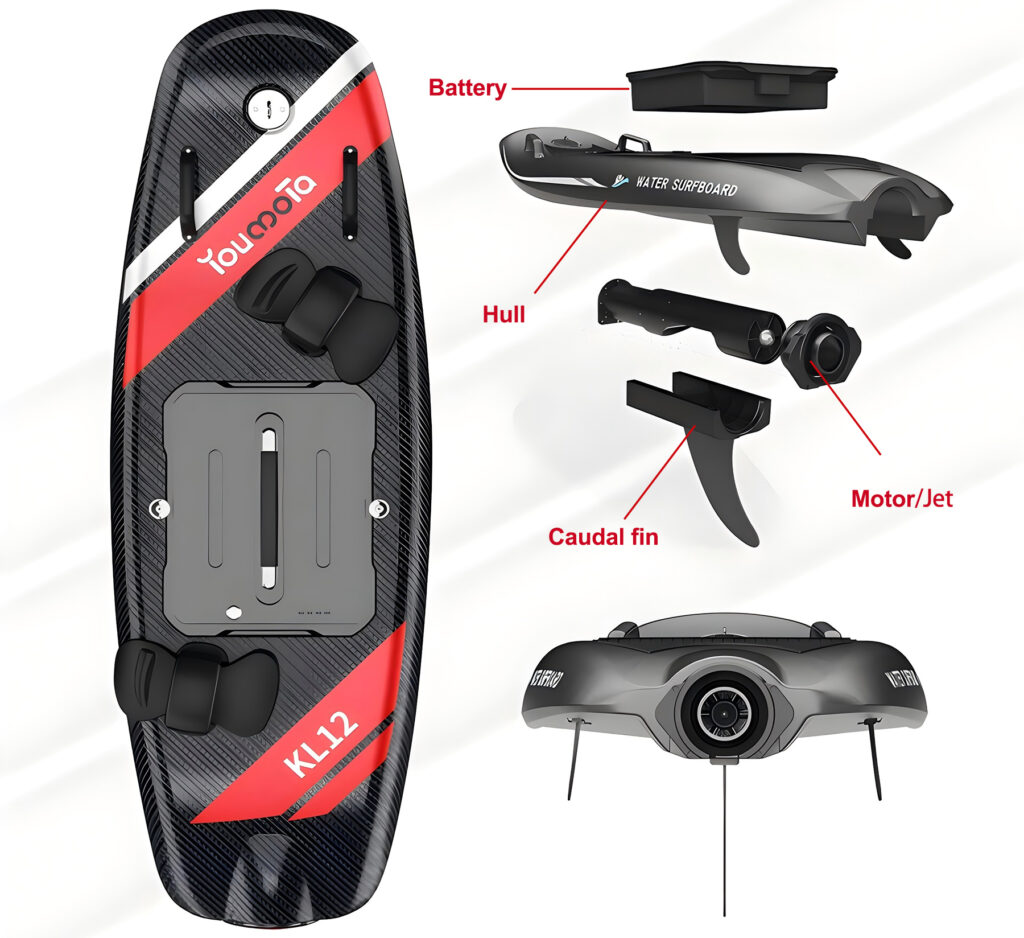Introduction to Electric Surfboards
Electric surfboards have revolutionized the way people experience water sports. Powered by high-tech batteries, these surfboards allow riders to glide across the water at exhilarating speeds without needing to rely on waves. But what truly powers these boards? The answer lies in the batteries that make this all possible. In this article, we’ll dive deep into electric surfboard batteries, discussing their technology, performance, and everything in between.

Electric Surfboard
The Role of Batteries in Electric Surfboards
At the core of every electric surfboard is a powerful battery system. Without batteries, these surfboards would be nothing more than stylish planks. The battery provides the energy needed to propel the surfboard across the water, making it a crucial component of the overall experience. From lithium-ion batteries to innovations in battery tech, understanding how these power sources work is essential for anyone interested in electric surfing.
Understanding Electric Surfboard Batteries
What Makes Electric Surfboard Batteries Unique?
Unlike standard batteries used in everyday devices, electric surfboard batteries are designed to withstand extreme conditions. These batteries need to be waterproof, lightweight, and capable of delivering high power outputs to ensure smooth performance on the water.
Types of Batteries Used in Electric Surfboards
Most electric surfboards rely on lithium-ion batteries due to their efficiency and lightweight nature. However, there are also other battery types in development that aim to offer improved performance and longer lifespan. The focus remains on creating a balance between battery life, weight, and power output.
Battery Technology in Electric Surfboards
Lithium-Ion Batteries
Lithium-ion batteries have become the standard in electric surfboards for a reason. They provide a high energy density, which means more power in a smaller, lighter package. This is crucial for surfboards, where weight and size matter for maneuverability and performance.
Pros and Cons of Lithium-Ion Batteries
Like any technology, lithium-ion batteries have their pros and cons. The benefits include fast charging times, high power output, and relatively long lifespans. However, they also come with drawbacks like sensitivity to temperature extremes and potential safety risks if not handled correctly.
Battery Capacity and Performance
Range and Speed: The Impact of Battery Performance
Battery performance directly impacts how fast and how far you can travel on an electric surfboard. A well-maintained battery can provide higher speeds and longer ranges, making for a more thrilling ride. However, factors like water conditions, weight, and board design also play a role. Several factors can influence the overall lifespan of an electric surfboard battery, including usage patterns, charging habits, and environmental conditions. For example, frequent full discharges or exposure to extreme temperatures can shorten the battery’s lifespan.
Charging Electric Surfboard Batteries
Charging Time and Methods
Charging time varies depending on the battery’s capacity and the charger being used. Most electric surfboards come with dedicated chargers designed to quickly and safely recharge the batteries. Charging typically takes anywhere from 2 to 6 hours.
Safety Tips When Charging
When charging an electric surfboard battery, it’s essential to follow safety precautions. Always use the manufacturer’s recommended charger, avoid charging near water, and ensure the battery is kept in a dry, cool environment.
Battery Maintenance and Care
Best Practices for Extending Battery Life
Proper care and maintenance can significantly extend the life of your electric surfboard battery. Avoid exposing the battery to extreme temperatures, and store it at a partial charge when not in use for extended periods. Regularly checking for signs of wear and tear is also recommended.
How to Store Electric Surfboard Batteries Safely
When not in use, electric surfboard batteries should be stored in a cool, dry place. Storing batteries at around 50% charge can help preserve their lifespan, especially if they won’t be used for a while.
Battery Replacement
Signs It’s Time to Replace Your Battery
Over time, even the best-maintained batteries will start to lose their efficiency. Signs that it’s time for a replacement include shorter ride times, difficulty holding a charge, or noticeable physical damage to the battery.
How to Choose a Replacement Battery
When replacing your electric surfboard battery, make sure to choose a battery that is compatible with your surfboard’s model. Look for reputable brands and consult with the manufacturer to ensure you’re getting a reliable, high-quality replacement.
Safety Concerns with Electric Surfboard Batteries
Common Safety Issues with Batteries
Electric surfboard batteries, like all lithium-ion batteries, can pose safety risks if not handled correctly. Overcharging, exposure to high temperatures, and physical damage can lead to overheating or even fires in extreme cases.
Preventing Overheating and Damage
To prevent battery issues, always follow the manufacturer’s guidelines for charging and maintenance. Avoid exposing the battery to direct sunlight for extended periods and regularly inspect it for any signs of damage.

